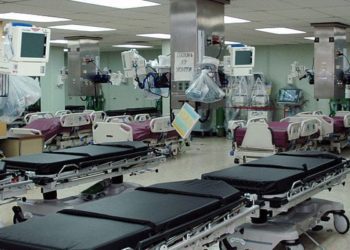Nanoparticles targeting immune cell surface proteins may protect from sepsis [PreClinical]
1. Nanoparticles loaded with sialic acid molecules (α2,8 NANA-NPs) targeted sialic acid-binding immunoglobulin-like lectins (Siglecs) on immune cell surfaces.
2. Treatment with α2,8 NANA-NPs led to increased survival and decreased inflammation in a variety of murine sepsis models, as well as reduced inflammation in human cells in vitro and in an ex vivo lung perfusion (EVLP) model.
Evidence Rating Level: 1 (Excellent)
Study Rundown: Uncontrolled inflammation throughout the body in response to infection, termed sepsis, is a leading cause of death in hospitalized patients. Sepsis is known to be mediated through toll-like receptors on immune cell surfaces, whose activity is inhibited by Siglecs. The authors of this study therefore designed α2,8 NANA-NPs to bind and activate Siglecs.
Initial in vitro studies used lipopolysaccharide (LPS) to induce inflammation in mouse macrophages and showed that α2,8 NANA-NPs reduced levels of inflammation markers by specifically binding to Siglec. Intraperitoneally injecting mice with α2,8 NANA-NPs together with or 2 hours following LPS injection enhanced survival and decreased inflammation in comparison to controls. A more relevant model induced sepsis in mice via cecal ligation and puncture (CLP). Subsequent periodic intraperitoneal injection of α2,8 NANA-NPs increased survival and decreased other signs of infection as compared to control treatments. In a model of pulmonary inflammation, mice treated intratracheally with α2,8 NANA-NPs several hours after CLP showed increased survival and fewer signs of inflammation than controls. Incubating human macrophages and monocytes activated by LPS with α2,8 NANA-NPs reduced levels of inflammatory markers. Furthermore, a human EVLP model showed that pulmonary edema induced by LPS was reduced by treatment with α2,8 NANA-NPs.
Preliminary studies by the authors have demonstrated that α2,8 NANA-NP administration is nontoxic, but further safety evaluations are needed before advancing this technology to clinical studies. Overall, this work presents a powerful new mechanism-based approach to preventing sepsis and ARDS.
Click to read the study in Science Translational Medicine
Relevant Reading: Siglec-E Is Up-Regulated and Phosphorylated Following Lipopolysaccharide Stimulation in Order to Limit TLR-Driven Cytokine Production
In-Depth [animal study]: Peritoneal macrophages from C57BL/6 mice were exposed to LPS along with α2,8 NANA-NPs or nanoparticles without attached molecules (Nude-NPs). Only α2,8 NANA-NPs decreased concentrations of the cytokines tumor necrosis factor-α (TNF-α) and interleukin-6 (IL-6) (p<0.001), an effect which disappeared when Siglec activity was inhibited.
Intraperitoneally injecting 6 mg/kg LPS together with 2 mg Nude-NPs caused lethality in 7 out of 8 mice within 32 hours, while all 8 mice treated with 2 mg α2,8 NANA-NPs survived until the study endpoint of 50 hours (p<0.001). The latter group also had lower blood serum TNF-α levels at 24 hours (p<0.001). Similar trends were observed when NPs were administered 2 hours following LPS injection. In the CLP model of polymicrobial sepsis, mice were treated at 2 hours following CLP and every 24 hours thereafter. Mice treated with 2 mg α2,8 NANA-NPs showed enhanced survival as compared to the Nude-NP-treated mice (p<0.001, n=8-10 per group), as well as decreased clinical scores of infection and improved body temperature maintenance. Intratracheal administration of 20 µg α2,8 NANA-NPs at 6-8 hours after CLP surgery also increased survival (not significant) and decreased clinical scores in comparison to Nude-NP-treated mice (p<0.05 at 24 and 36 hours post-surgery, n=12-13 per group).
In human cell studies, incubating LPS-activated monocyte-derived macrophages with 25 µg/mL α2,8 NANA-NPs decreased levels of TNF-α (p<0.001), IL-6 (p<0.05), and IL-8 (p<0.05) in comparison to Nude-NP treatment. Similar results were observed with monocytes. In a human EVLP model, lungs were perfused with LPS and either α2,8 NANA-NPs or saline. The α2,8 NANA-NPs group showed decreased pulmonary edema at 4 hours after treatment, as measured by the wet-to-dry weight ratio of lung tissue (p<0.05, n=3 per group).
Image: PD
©2015 2 Minute Medicine, Inc. All rights reserved. No works may be reproduced without expressed written consent from 2 Minute Medicine, Inc. Inquire about licensing here. No article should be construed as medical advice and is not intended as such by the authors or by 2 Minute Medicine, Inc.

![Adverse pregnancy outcomes associated with thrombophilias [Classics Series]](https://www.2minutemedicine.com/wp-content/uploads/2015/07/Classics-2-Minute-Medicine-e1436017941513-350x250.png)





